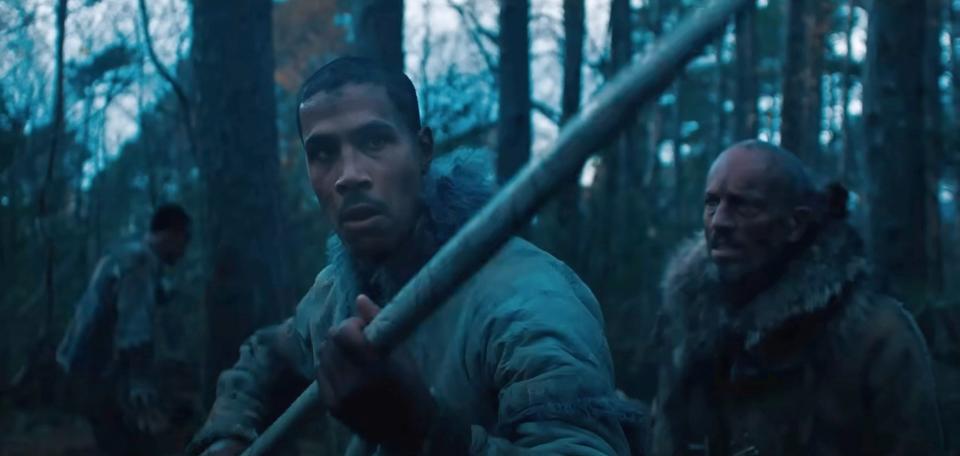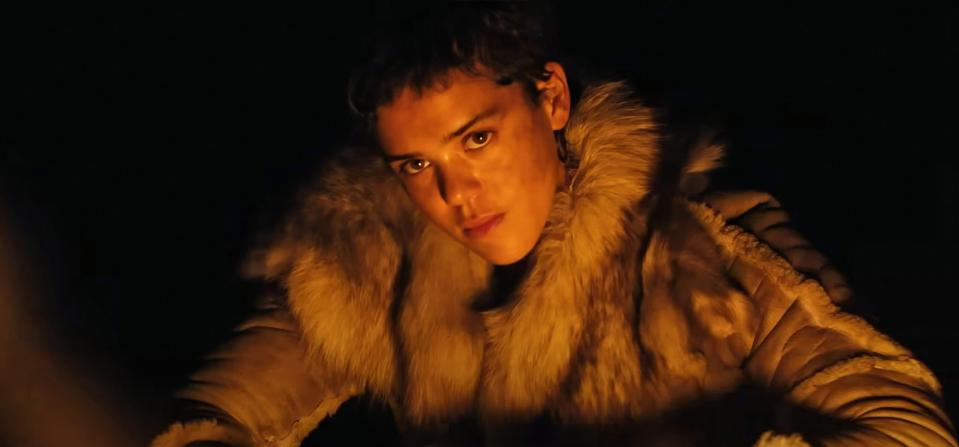Just How Committed Is ‘Out of Darkness’ to Its Pre-Historic Era? It Invented a Language

Director Andrew Cumming’s new horror film “Out of Darkness” is a survival movie that recalls classics of the genre like Wes Craven‘s “The Hills Have Eyes,” John Carpenter‘s “The Thing,” and Tobe Hooper‘s “The Texas Chainsaw Massacre” in its tale of a small group under siege by a malevolent force in a hostile, isolated environment. What makes “Out of Darkness” unique is its time period: Its heroes and the unseen monster they’re fleeing exist in a pre-historic world.
This meant Cumming and screenwriter Ruth Greenberg had to figure out how people living in 43,000 BCE would talk, fight, and dress and what kinds of weapons and tools they would use. One of the first people Cumming consulted during the writing phase was Palaeolithic archaeologist Rob Dinnis, who liberated Cumming and Greenberg to create characters to whom modern audiences could relate. “There seem to be two schools of thought within this field,” Cumming told IndieWire. “The old school method says that if we didn’t dig it out of the ground, we can’t prove it, which is reasonable. But Rob is part of a newer school that says that if we can do it, early humans could do it, they just did it differently.”
More from IndieWire
'Twisters' Super Bowl Teaser: Lee Isaac Chung Chases Blockbuster Storms in Sequel to 1996 Original
'Wicked' Teaser: Ariana Grande and Cynthia Erivo Defy Gravity in 'Wizard of Oz' Prequel
According to Dinnis, “The view of primitive, club-wielding cavemen is a hangover from more than 100 years ago and has been rejected in scientific circles for many years now. Humans at this time would be perfectly recognizable as like humans in the modern day: They created colored, carefully tailored and decorated clothes; their tools were extremely complex and allowed them to impressively exploit their environments; they had fully formed language, and created art and music in a way familiar to us now.” Dinnis turned Cumming on to numerous locations and books that helped him build the world and informed Cumming’s ideas regarding casting.
“He said there’s certain data and patterns of movement that would suggest that these people had dark skin,” Cumming said. “So from very early on, I was imagining, OK, this is going to be unlike a lot of films set in this time period because we’re not going to be casting Caucasian actors. The casting director and I only looked for actors that identify as mixed heritage, mixed race, because it felt the closest to the research.” Although the audition process began conventionally, as the filmmakers got closer to making their final selections, the actors had to audition in a completely fictional language created for the movie — a decision Cumming had arrived at with no small amount of anxiety.
“I really got afraid that the film was already such a big ask of the audience, and I was worried that tiny words on the screen might put people off what was already such a big swing,” Cumming said. As he and Greenberg worked on the script, however, they realized that if the characters spoke English, it would feel phony and distracting. “Also, we ended up casting actors from the U.K., Switzerland, and Germany, and those accents together would have ruined the illusion I was trying to create, that this was a cohesive tribe.”
To create the fictional language that the characters would speak, Cumming relied on poet, historian, and linguist Daniel Andersson, who approached his task from a thematic perspective. “The film is basically about how one thing is or is not like another,” Andersson told IndieWire. “The question for me was, what is going to be the balance between engagement and alienation, between something that you know and something that you don’t know when the language is presented.” Andersson’s goal was to create a few keywords that the audience would ultimately recognize and carry associations with by the end of the film; by the time the climax arrives, we know the word for “monster,” for example, and this awareness aids in the creation of suspense.

One challenge of creating a new language for a film is that the audience doesn’t perceive it in a completely pure way; as Andersson points out, people’s eyes are moving back and forth between the action and subtitles, something that needs to be taken into account when building the language. “There’s clearly going to be an interplay, so how do we engage with it?” Andersson said. Knowing that audiences would be able to, at a very limited level, learn the new language by connecting the spoken words with the subtitles as well as with the action on screen, Andersson tried to associate a handful of words and sounds with certain themes and images, whether it be movement restriction or the monster. “The idea is to create a bit of brain memory that serves the broader purpose of the film.”
Cumming says that initially the invented language, known as TOLA (for “The Origin Language”), was extremely challenging for the actors, who essentially just listened for the final words of each other’s dialogue so they knew when they could start talking. As production progressed, however, they became more comfortable and familiar with the language — much as the audience does over the course of the film — and the acting process began to resemble something more traditional. “By the end of the shoot, they were actually starting to improv in TOLA,” Cumming said, noting that when he realized the actors had made the language their own and believed in it, it gave him hope the audience might believe in it as well.
Another key to making the audience believe in the world is the cinematography, which created tricky lighting challenges for Cumming and director of photography Ben Fordesman. “There are no cheats, right? You can’t put on the car headlights or anything like that,” Cumming said. “The daytime scenes are, in a way, the easiest, but even then we didn’t use any artificial light. Everything was just bouncing stuff off polyboards and putting in ND filters to give more shape and more contrast to the faces. And then you work with the grader down the line to inject color and more of a look later. I think Ben did a really great job on those scenes to make the Scottish Highlands look bleak yet completely beautiful and awe-inspiring, which is exactly what I wanted.”

For the nighttime scenes, the lighting was motivated almost entirely by fire, which is not only a key visual element but also a vital part of the story. “If they don’t have fire, they die,” Cumming said. “They don’t eat, they don’t stay warm. I remember we used to joke because most of Ben’s direction to his team was either more gas or less gas, just to bring the fire up or down just to get the right amount.” Even in the film’s most striking visual effect, an Aurora Borealis scene, Cumming and Fordesman kept the lighting simple. “It’s just one sky panel up high, and I think we programmed it on an iPad to give it a sort of strobing effect.”
The film’s composer, Adam Janota Bzowski, created an additional layer of period authenticity by rigorously researching ancient instruments and applying their sounds to his score. “Again, it was all about taking inspiration from what we know about these people from that time period,” Cumming said. “Bone flutes have been discovered at various dig sites, so he used bone flutes. He also spoke to a conch flute expert in Australia and had him record sounds that he could then sample and process and pitch up and down, and there are kudu horns. Basically, it was just taking any sort of percussive instruments or wind instruments from that time period and then going to town with them and putting them through various filters. I think Adam was surprised himself at how violent he was able to make these things sound.”
All of these elements give “Out of Darkness” a mesmerizing quality that Cumming strove for even as he was terrified it wasn’t achievable on his first feature. “Especially in your debut, there are a lot of high-wire moments where you’re worried that it’s not going to work. The world building is such a crucial part of a film like this. But ultimately I said to my heads of department throughout the process, we’re not making a documentary. We’re not making a Discovery Channel reenactment. This is a movie, and it’s got to do certain things that a movie has to do. So, you know, do the research, but don’t become beholden to it.”
Best of IndieWire
Where to Watch This Week's New Movies, Including 'Argylle' and 'How to Have Sex'
Christopher Nolan's Favorite Movies: 40 Films the Director Wants You to See
Sign up for Indiewire's Newsletter. For the latest news, follow us on Facebook, Twitter, and Instagram.

